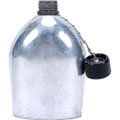Several readers have sent in questions about the dangers of chemical leaching from plastic bottles. A composite version:
Dear Umbra,
I’ve read some conflicting things about the risks associated with reusing plastic water bottles. For instance, the generally trustworthy folks at the urban-legends site snopes.com have criticized a widely circulated email that claims regular water bottles are not safe for refilling because the plastic breaks down. The commonly offered solution is to refill only bottles made from stronger plastics, which are meant to be washed and reused, such as Nalgene bottles. But then I read in Daily Grist that even Nalgene bottles may leach a dangerous chemical into water. Is there some kind of bottle I can reuse without running these risks?
Conglomerate Reader
Everytown, U.S.A.
Dearest Conglomerate Reader,
The mysterious world of plastics: convenient, yet filled with vague and shadowy dangers. Lest we get overly mired in those dangers, let’s take a moment to recognize the incredible advances — in medicine, for example — that plastics have brought to our lives. Not only does plastic serve valuable purposes, but its manufacture is in many cases no more hard on the earth than the manufacture of wood-based products. Paper versus plastic bags? It’s a draw.

I’m a Nalgene bottle, baby.
Now that we’re through with plastic appreciation …
Manufacturing plastic is resource-intensive and yields various nasty emissions that contribute to global warming and degradation of water quality. It’s made from non-renewable resources, and for all intents and purposes, it never biodegrades (although some specialized variations have been made specifically to do so). Yes, we’ll run out of oil eventually, but we’ll always have our plastic garbage. Add to this the growing suspicion that plastic use may lead to serious health problems.
Evil, evil plastics!, it would seem, and in some cases correctly. I would generally advise against using plastics in food- and beverage-related applications.
Let’s talk specifics, though, because you point out an apparent conundrum in your question. The contradictions you see in the press are a mix of confusion about types of plastic, misinformation, and bona fide scientific uncertainty about the effects of an entirely new group of substances. Snopes.com addresses purported links between PET (#1) and DEHA (di-2-ethylhexyl-adipate), a potential carcinogen, links which are apparently based on a study later shown to be bogus. PET evidently does not contain DEHA, and the carcinogenic properties of DEHA itself are hotly debated.
Nalgene bottles, made of polycarbonate (#7) or “Lexan,” are more closely linked to bad stuff, specifically an ingredient called bisphenol-A (BPA). BPA is an endocrine disruptor that mimics estrogen and has been linked to aneuploidy, adipogenesis, and other scary problems with funny names. Drinking water or eating food containing leached BPA may cause chromosomal disruption, miscarriages, birth defects, or obesity. Eek!
To recap what we know so far: #1 bottles are okay; #7 bottles are no good.
Moving on, I would categorically avoid PVC (#3), aka vinyl, for food containers or anything else. It truly is an evil plastic, practically a fount of dioxin. PVC containers and PVC film can contain oft-debated ickies DEHP and DEHA, and some contain softening phthalates linked to liver and kidney damage and testicular problems. Also, polystyrene (#6) is yucky — it’s made of styrene, and you don’t want any styrene in your precious bod, trust me.
That leaves us with the winners of this dubious contest: HDPE, LDPE, polypropylene, and limited use of PET.
Still, as I said, keep your food away from plastic. We are just beginning to learn what these chemicals have been doing to our bodies.
I’m also a little obsessed right now with a food-related health concern that often flies under our radar: bacteria. Reused, unwashed, and unsterilized plastic bottles are a breeding ground for invisible bacteria that nestle in cracks and scratches we cannot even see. It’s not as exotic as BPA and DEHA and styrene, but it is gross.

Smells like canteen spirit.
Where does that leave those who want to drink water on the go? After looking around on your behalf, I’ve put away my handy Nalgene bottle, which I was already feeling guilty about thanks to a rumor I heard several years ago about the company testing on rabbits. (Incidentally, it turns out Nalgene doesn’t test on bunnies, but it is owned by an octopus-like corporate conglomerate, another arm of which manufactures laboratory products used to experiment on animals — thus, it is boycotted by some animal-rights activists. Personally, I will focus my efforts on keeping plastics away from children.)
Glass vessels will work in low-impact situations, and I’ve seen metal canteens that may suit your needs. As long as we sit still, there’s no trouble finding plastic alternatives. It’s the biking and hiking and bungee jumping that pose a problem. Maybe those old leather canteens will make a comeback, but until then I think it’s the less-evil plastics that will keep us quenched on the trail.
Sadly,
Umbra
Editor’s Note: Read a January 2005 update and clarification on Nalgenes and other plastic bottles.


